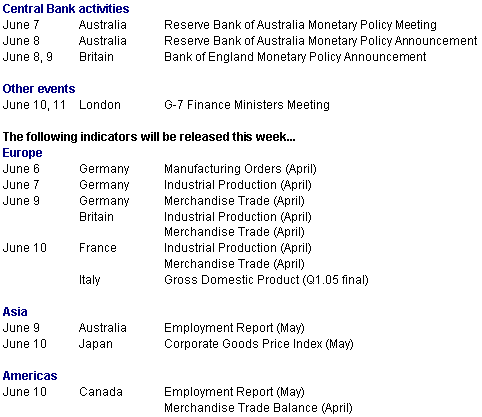Monday, June 6, 2005

What's next'
Just when I think I have read all there is to read about why the EU constitution failed its tests last week, there are yet more perspectives and rhetoric on what it all means. Briefly, the no votes in the Netherlands and France were in part brought about by dissatisfaction with their national governments, especially in France. But there was more. The European constitution is virtually incomprehensible to the lay public. The public saw soaring unemployment and anemic economies - things that integration was supposed to eradicate. In the Netherlands, financial contributions to the EU are the highest per capita of anyone. But in France and Germany, voters are suspicious of changes that may hurt protections for workers' pay, pensions and job security. In short they are not willing to do away with the rigidities that prevent the economies from becoming more competitive and open to market forces. Leaders will debate what is next for the constitution at a summit in Brussels on June 16th and 17th.
What the constitution would do is create a permanent EU president and foreign minister for the first time and smooth a decision-making process designed in the 1950s when the region had only six members. Opponents in France said it did too much to open the door to unrestrained British-style capitalism. In the aftermath of the vote, the main concern is likely to be the pace of economic reform. French politicians have clearly taken the vote as a rejection of the "Anglo-Saxon model". Now they are likely to fight even harder against liberalizing reform measures.
Meanwhile on Thursday, it was business as usual at the European Central Bank meeting. The ECB refused to cut interest rates for a 25th month leaving their policy rate at 2 percent. ECB president, Jean Claude Trichet, continued to repeat his mantra that rates are "very favorable" to economic growth. He continually rejects rate-cut calls from politicians including Italian Prime Minister Silvio Berlusconi and the Organization for Economic Cooperation and Development (OECD) and Germany's Ifo Institute.
The ECB lowered its 2005 growth forecast for the third time in six months, reducing its projection to about 1.4 percent from 1.6 percent. The region's growth outlook has deteriorated as a 30 percent surge in oil prices this year boosted costs and high unemployment hurt consumer spending. Trichet rejected speculation about a disintegration of the EMU after the referendums saying it is "totally absurd". Interest rates have risen in the U.S. to 3 percent while the Bank of England rate remains at 4.75 percent.
Global Markets
What a week! Aside from the data deluge, which included the world's most watched indicator - the U.S. employment situation report - they had to deal with the double rejection of the EU proposed constitution. The fallout from the No votes pushed the euro down 2.8 percent against the dollar last week. All equity indexes with the exception of the Dow and Nasdaq were up on the week.
Global Stock Market Recap

Europe and Britain
Equities were sanguine despite the French no-vote the last weekend. Monday's muted market response to the French "non" vote was clearly due to narrow markets (London and New York were closed). But stocks were up in Europe as one would expect as the lower euro made exporters' stocks appear more favorable. Exporters had been struggling to maintain market share rather than raise prices to help profits. Now the weaker currency would take pressure off. Helping exporters were shares of mining companies which are considered attractive buys amid optimism that metal prices will continue to increase and in turn lift profits.
The FTSE closed over the key 5,000 barrier on Wednesday hitting a three-month high after a broad-based rally on European exchanges followed firm gains on Wall Street, where data indicated that interest rate increases could be reaching an end soon. Investors in Europe and Britain seemed to pay little attention to their own purchasing managers' surveys that showed the manufacturing sector shrinking.. The FTSE was unable to maintain its hold above the 5,000 level by close of trade on Friday following disappointingly weak U.S. employment data. The CAC, DAX and FTSE were up on the week.

The sinking euro
When traders in the U.S. and Britain returned to work on Tuesday, they duly pushed the euro down to a seven-month low against the dollar. The pressure on the euro picked up steam on Wednesday as markets awaited the outcome of the Dutch vote. Confirmation of a decisive defeat brought even more downward pressure on the euro just as markets were closing in North America. The euro tumbled to a fresh eight-month low of $1.2168 against the dollar as the magnitude of the Dutch rejection - 62 percent versus 38 percent - became clear. The euro stabilized somewhat on Thursday. The overall decline was fanned by comments concerning the viability of the EMU without the accompanying political integration.

The euro came under renewed attack in European morning trade on Friday as an Italian minister called on his country to reintroduce the lira because the euro had proved inadequate in the face of the economic slowdown, the loss of competitiveness and the job crisis. He suggested Italy should revert to dual circulation of the lira and the euro to help solve these problems. While many analysts played down the possibility of the EMU being reversed, there was an acceptance that lingering fears are likely to continue to weigh on the euro for a while. However, Friday's trading was dominated by U.S. employment data which was weaker than expected by analysts. The euro jumped above the $1.23 level on the data, only to sink below it on uncertainty over the constitution's defeat.
Asia/Pacific
All six Asia/Pacific equity indexes followed here were up last week, building on May gains in the first few days of the new month. Japanese stocks were buoyed by retail stocks which benefited from an unemployment rate now at a six-year low and household spending which was up for the first month in three months. Both the Nikkei and Topix are rebounding amid evidence that the economy is improving.
The May Japanese annual earnings season is over with profits having a third good year in a row. Corporate Japan is forecasting yet another increase for 2005-06. If they are correct, it will be a historic moment - the first time since the 1970s that corporate profits have risen for four years running. But analysts are questioning the quality of the earnings increases - they say they are mostly a result of cost cuts from staff reductions.

The Bank of Japan allowed liquidity to fall below its ¥30,000 billion floor for the first time since it introduced ultra-loose policy in March 2001. Under the BoJ's quantitative easing framework, the bank floods the market with excess liquidity. But many market participants now expect the bank to gradually mop up liquidity in preparation for a return to an orthodox policy - targeting interest rates.
The yen weakens, then reverses direction
The yen sank to 108.33 per dollar after the Bank of Japan allowed the amount of funds it pumps into the banking system to fall below its target for the first time in response to weaker demand from lenders. Atsushi Mizuno a voting member of the BoJ monetary policy board, said that the central bank should move toward ending its policy of plowing cash into the economy in a year. But the yen regained ground after the U.S. employment report disappointed market players.

Indicator scoreboard
EMU - May economic sentiment dropped to 96.1 from 96.5 in April. Both industrial and consumer sentiment declined. Industrial sentiment dropped to minus 11 from April's reading of minus 9. Consumer sentiment declined to minus 15 from minus 13 in the previous month. However the service sector was up with a reading of plus 10 from plus 8 previously. Retail sentiment was unchanged with a reading of minus 8.

May flash harmonized index of consumer prices was up 2 percent when compared with last year. As with all flash estimates, no breakdown of the data was provided. The reading matches the ECB inflation target of 2 percent.

M3 money supply for the three months ending in April was up 6.6 percent when compared with the same three months a year ago. The ECB M3 money supply target is 4.5 percent for the Bank's preferred measure - the 3-month moving average. For the month of April, M3 was up 6.7 percent on the year.

First quarter gross domestic product was up 0.5 percent and 1.3 percent when compared with the same quarter a year ago. Growth was due to increased net exports. Domestic demand was unchanged on the quarter while government consumption and gross fixed capital formation declined on the quarter.

April seasonally adjusted unemployment rate remained at 8.9 percent for the fourth month. Ireland recorded the lowest rate - 4.2 percent while Spain and Germany registered the highest - 10 percent.

May manufacturing purchasing managers index dropped to 48.7 from 49.2 in April as business conditions in the sector continue to deteriorate. The rate of decline was the fastest seen for twenty-two months. The downturn in the PMI partly reflected a stagnation of manufacturing output in May. The overall standstill of production growth reflected a further weakening of order book trends. New orders declined for the second month in a row and at the steepest rate since June 2003.

The service sector business activity index rose from 52.8 in April to 53.5 signaling an increase in activity for the twenty-third month running. The rate of increase was the strongest recorded for seven months, but remained well below that recorded a year ago. Further growth of activity was driven by an increase in demand for services, but also by firms eating into backlogs of work and offering discounts to win sales. Employment rose for the tenth successive month, but at only a very modest rate. Upward pressure on input costs abated in May. Both the manufacturing and services indexes are compiled by NTC Research in Britain.

April real workday and seasonally adjusted retail sales were down 1.2 percent and declined 0.9 percent when compared with last year. Food, drink and tobacco sales sank 1.6 percent while nonfood sales were down 0.6 percent.

April industrial producer prices were up 0.4 percent and 4.2 percent when compared with last year. Excluding energy, the PPI was up 0.1 percent and 2.1 percent on the year. Energy prices were up 1.9 percent and 13.2 percent on the year.

Germany - May seasonally adjusted unemployment rate remained at 10.8 percent for the second month. The unemployment rate inched back to 19.1 percent from 19.2 percent in the east but remained at 9.8 percent in the west for the second month. Unemployment was flat for all of Germany - an increase of 11,000 in the west was offset by a decline of 11,000 in the east. Total unemployment stood at 4.886 million in May. April employment was up by 14,000 jobs.

France - April seasonally adjusted unemployment rate remained at 10.2 percent for the second month. The number of jobless stood at 2.775 million according to the International Labour Organization definition, which excludes jobseekers who did any work during the month.
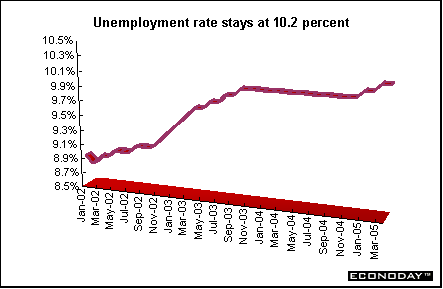
Italy - April producer price index inched up 0.1 percent and was up 4.4 percent when compared with last year. Increased energy and capital goods prices were offset by a decline in consumer goods on the month. Excluding energy the PPI was down 0.1 percent and up 2.2 percent on the year.

Britain - May CIPS manufacturing purchasing managers survey dropped to 47.3 from 49.1 in April. Activity was well below the key 50 contraction/expansion level. The decline can be traced to a sharp drop in output combined with weak new orders.
May CIPS services purchasing managers index slipped to a reading of 55.1 from 56.5 in April. Although indicative of robust growth, the latest index reading was the lowest since February. New business improved for a twenty-fifth consecutive month. The slowdown of sales growth helped to explain a similar easing in the rate of employment expansion. Although maintained for a 22nd successive month, growth of the service sector workforce was only modest and the slowest since February. There was a further sharp increase of input prices in May, reflecting higher energy, fuel, utility and wage costs.
May Nationwide house price index was up 0.3 percent and 5.5 percent when compared with last year, a level (say what the level is') not seen since August 1996. Nationwide has forecast that house prices on a national level are set to only rise 2 percent in 2005, which would mark the lowest inflation rate for a decade.
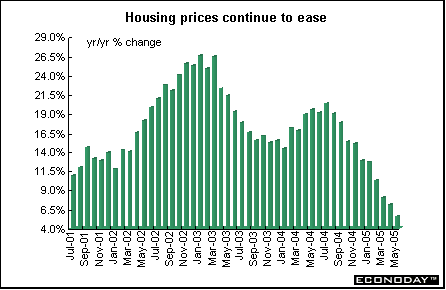
Asia
Japan - April seasonally adjusted industrial production was up 2.2 percent and 1.8 percent when compared with last year. Output of cars, trucks and other vehicles gained 6.2 percent in April from the previous month. Steel production was up 2.8 percent while precision machinery soared 18.3 percent and electric machinery increased 9.6 percent.
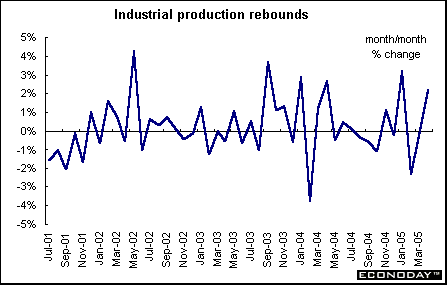
April unemployment rate declined to 4.4 percent from 4.5 percent in the previous month. The unemployment rate was the lowest since December 1998. Employment rose by 410,000 people, today's report showed, and the workforce expanded by 370,000. The number of unemployed was 2.93 million.

April seasonally adjusted spending by households headed by a salaried worker climbed 3.5 percent from March and was down 2.8 percent when compared with last year.

Australia - April retail sales were down 0.6 percent but up 2.7 percent when compared with last year. Sales were hit by the hottest April in 146 years which caused demand for winter clothing and heaters to slump. (It's winter down there.) Department store sales dropped 11.3 percent and clothing sales fell 7 percent.
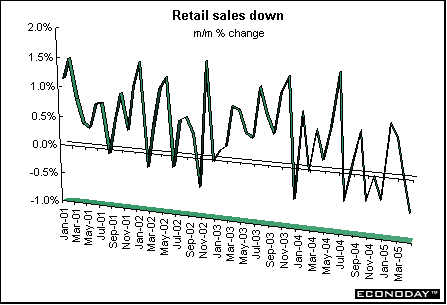
First quarter gross domestic product was up 0.7 percent and 1.9 percent when compared with the same quarter a year ago. Business investment was down 2.6 percent in the first quarter. The change in net exports, which measures exports minus imports, subtracted 0.3 percentage points from GDP. Hit by a drought, farming production (which includes wheat, cotton, wool and meat) was down 0.1 percent in the quarter and slumped 16.1 percent from a year earlier. Consumer spending was up 0.8 percent.

April merchandise trade deficit narrowed to A$1.33 billion ($1 billion), the lowest since January 2003, from A$2.64 billion in March. Exports soared by 9.3 percent while imports edged downward by 0.4 percent. Shipments of non-rural goods, which include metals and minerals, surged 14 percent from March. Rural goods, such as meat, sugar, wheat, and wool, gained 7 percent. Exports of services, which include tourism spending, fell 2 percent. Commodities make up more than 50 percent of Australia's exports, which in turn account for one-fifth of GDP. Imports of intermediate goods, which include oil and spare parts, dropped 5 percent. Australia's imports of capital goods, which include business machinery, increased 9 percent.

Americas
Canada - April industrial product price index was up 0.5 percent and 1.5 percent when compared with April in the previous year. The monthly increase came from a combination of higher prices for petroleum products, motor vehicles and other transport equipment, pulp and paper products, chemical products and electrical and communication products.
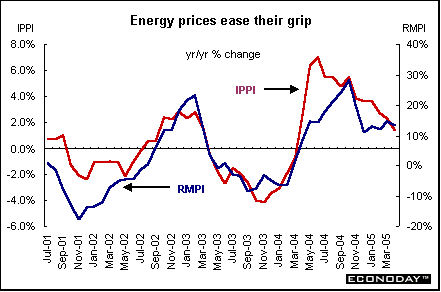
April raw materials price index was down 1.6 percent but was up 13.3 percent when compared with last year. Prices were down on the months for mineral fuels, animals and animal products, non-ferrous metals as well as vegetable products.
Between March and April, the value of the Canadian dollar fell 1.6 percent against the U.S. dollar. As a result, if the impact of the exchange rate had been excluded, the IPPI would have been unchanged on the month compared to the actual 0.5 percent increase. On a 12-month basis, the value of the Canadian dollar rose 8.6 percent against the U.S. dollar. If the impact of the exchange rate had been excluded, producer prices would have risen 3.7 percent between April 2004 and April 2005, rather than their actual 1.5 percent increase.
First quarter gross domestic product was up 0.6 percent and 3.3 percent when compared with the first quarter in 2004. Consumer spending surged ahead 1.5%, led by strong increases in purchases of durable and semi-durable goods, such as home furnishings, and clothing and footwear. Overall business investment in plant and equipment increased 3.0 percent led by the strength of investment in machinery and equipment and the first quarterly increase of investment in non-residential structures in over a year.
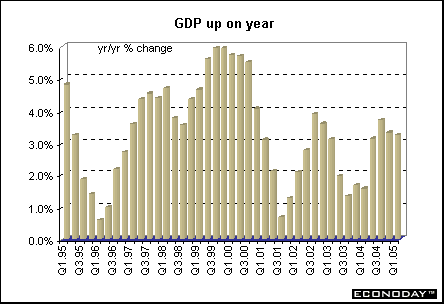
Bottom line
Recriminations and rhetoric abound on the meaning of the French and Dutch vote. While most have some element of truth, many factors contributed to the constitution's demise. The hostile reactions of the French and Dutch people to enlargement, both recent and prospective, were one factor in their rejection of the treaty. Another reason is that the EU leadership lost touch with the populace and moved too quickly to implement change. While the constitution itself contained little concrete economic policy, voters in France in particular used their referendum to air their discontent with the EU's perceived "ultra-liberal" economic outlook. The weeks and months ahead will not be easy. The countries of Europe differ widely. The French, for example, want to keep their high-cost, high-regulation model. The British have chosen a different path, and have been more successful so far.
Looking Ahead: June 6 through June 10, 2005
